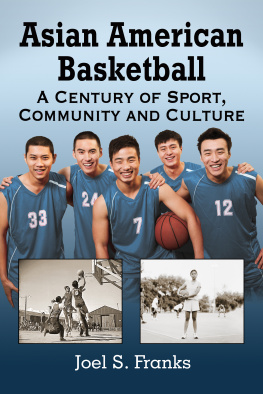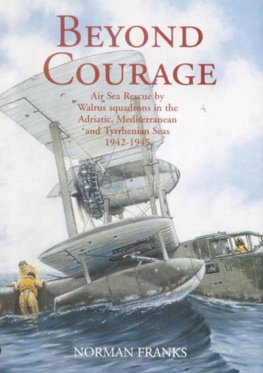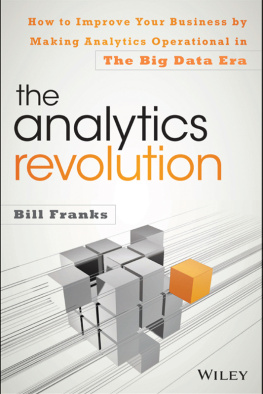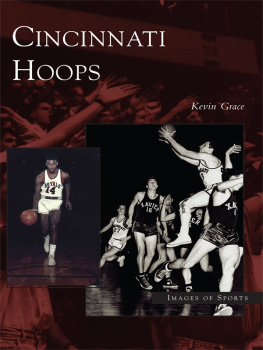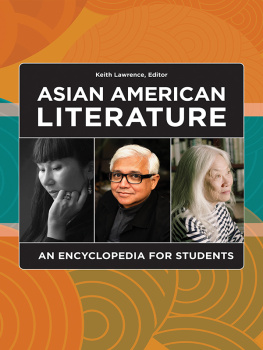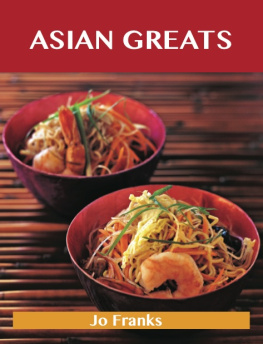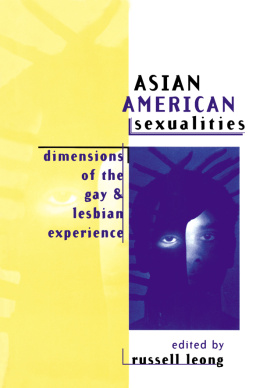
Also by JOEL S. FRANKS
The Barnstorming Hawaiian Travelers: A Multiethnic Baseball Team Tours the Mainland, 19121916 (McFarland, 2012)
Asian Pacific Americans and Baseball: A History (McFarland, 2008)
Asian American Basketball
A Century of Sport, Community and Culture
JOEL S. FRANKS

McFarland & Company, Inc., Publishers
Jefferson, North Carolina
LIBRARY OF CONGRESS CATALOGUING DATA ARE AVAILABLE
BRITISH LIBRARY CATALOGUING DATA ARE AVAILABLE
e-ISBN: 978-1-4766-2049-7
2016 Joel S. Franks. All rights reserved
No part of this book may be reproduced or transmitted in any form or by any means, electronic or mechanical, including photocopying or recording, or by any information storage and retrieval system, without permission in writing from the publisher.
On the cover: basketball team ( 2016 XiXinXing/Thinstock); Manzanar Relocation Center, Manzanar, California, 1943 (National Archives); girl with ball ( 2016 Blend Images/Thinkstock)
McFarland & Company, Inc., Publishers
Box 611, Jefferson, North Carolina 28640
www.mcfarlandpub.com
To my wife, Cheryl, and my children, Kaitlin and Spencerwith all my love
Acknowledgments
Inspiration for this book derives from many sources. To be sure, it came from watching and coaching my children, Kait and Spencer, as they sometimes struggled and sometimes triumphed in mastering the difficult game of basketball. Likewise, their teammates, opponents, coaches, and even referees inspired me. In particular, I want to remember one of my sons earliest coaches, the late Art Wong, who earnestly and patiently taught fundamentals to sometimes impatient seven-year-olds for Palo Alto Youth Services.
I have been helped along the way by conversations via telephone and e-mail with Mary Lai, Florence Chinn, Mel Orphilla, Peter Jamero, Colleen Matsuhara, and Chris Pung. In addition, my research has been aided by the Interlibrary Loan Department at San Jose State University; Santa Clara Universitys Department of Archives and Special Collections; Special Collections at California State University, Sacramento; Special Collections and University Archives, San Jose State; the University of San Francisco Archives; Schlesinger Library, Radcliffe Institute, Harvard University; University Archives for the University of Portland; David Silverman and the Harvard Athletics Department; Associated Students of UCLA; Oregon Nikkei Endowment; Fullerton Community College Library; Whitman University Special Collections; University of California, Irvine, Media Relations; University of Southern California Special Collections; University of Missouri Athletic Department; Long Island University Athletic Department; and the Japanese American National Museum.
Preface
I have to confess that this book was inspired by Linsanity. As I write these words, there have already been numerous articles, books, and at least one documentary on the market examining Jeremy Lins young life, struggles, and faith in the wake of the Taiwanese Americans emergence as a surprising, excessively hyped, albeit perhaps temporary, National Basketball Association (NBA) star in the winter and early spring of 2012. And as I write these words, it is hard to predict where Lins professional basketball career will go. He left the New York Knicks, for whom he excelled for several weeks in 2012 before a knee injury put him on a shelf. Instead of plying his trade in New York City, he headed to Texas on the winds of free agency and was most recently in Houston, performing for the Rockets. Thus far, he seems to have disappointed his most rabid detractors and fans. That is, he has evidenced the talent, courage, an d basketball know-how to become a productive NBA player for many years, but probably not a superstar or even a star. Regardless, even if he stopped playing basketball at the end of the 20132014 season, we should still consider Lin a source of pride to his family and those communities, spiritual and secular, which matter the most to him. But more than that, his deft moves at driving the lane compelled many Americans to consider, if but for a moment, the complex experiences of Asian Americans and that maybe the stereotypes that have comforted many of us were dissolving.
Thus, while motivated in part by the Bay Arearaised and Harvard-graduated Lin, this book is more concerned with one of the things that Jeremy Lin seemed to represent to people in the late winter of 2012the legacy of Asian American basketball, which has nourished not only Jeremy Lin but countless children and adults of Asian ancestry who have played, coached, and watched basketball in the United States for decades. And perhaps just as important, if not more so, people found in Jeremy Lin a way to interpret the experiences of Asian Americans in general.
As someone who has taught Asian American studies, researched and written books about Asian American athletic and nonathletic experiences, and coached in an Asian American youth league in the Bay Area, I found much of the reaction to Jeremy Lins success as a New York Knick in 2012 somewhat curious. Like many, I, too, was surprised that a Harvard grad could hold his own against the finest basketball players in the world. Like many, I, too, was surprised that a basketball player cut by not one but two NBA teams, including my favorite NBA contingent, the Golden State Warriors, could not just find a place on the Knicks bench but at the time substantially shape the Knicks into one of the most exciting teams in the NBA. Unlike many, however, I was not surprised that a person of Asian ancestry could develop into a decent NBA or, for that matter, Womens National Basketball Association (WNBA) performer. But I remained at least somewhat surprised and disappointed that it had taken so long for it to happen.
Perhaps cultural, economic, and demographic factors have stymied the fostering of a visible cohort of Asian American elite basketball players. Moreover, we need always consider the haunting presence of racism. Indeed, despite the fact that horrors such as the Chinese Exclusion Act and Japanese American internment camps in World War II might seem well behind the United States in the second decade of the twenty-first century, racisms traveling eye, to borrow a phrase from scholar Elaine Kim, trails Asian Americans, if not as closely as other nonwhite Americans, closely enough. Still, wherever Americans of Asian ancestry have put down roots, they have played basketball with passion and frequently skill. And that is why I remain a bit astonished that so many are astonished that somebody of Jeremy Lins racial identity should be able to find at least a modicum of success in the NBA.
Accordingly, it seems to me that Asian American basketballs most consequential stories transcend Jeremy Lin. One of these stories concerns the Asian American community teams and leagues that have historically linked generations, social classes, and males and females from Boston to Honolulu. Perhaps just as significant, another notable story concerns the relatively anonymous Asian Americans who have crossed often treacherous cultural borderlands to play on predominantly nonAsian American high school, junior college, and college teams. In other words, if Jeremy Lin had never gotten off the NBA bench, Asian American experiences with basketball in general would still be worth chronicling as a way to talk about both the limitations and possibilities of sport in America, and America itself.
Next page
